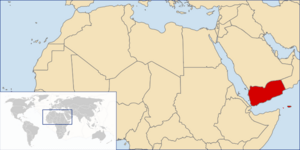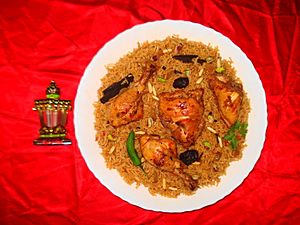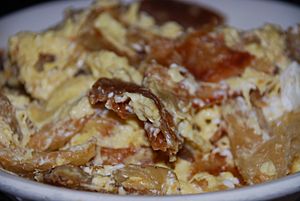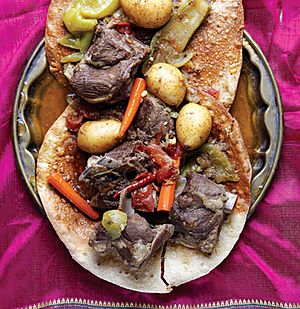Yemeni cuisine facts for kids

Yemeni food is special and different from other Middle Eastern foods. But it also has some local differences. For example, you might see influences from Ottoman food in Sanaa. In southern areas like Aden and Mukalla, you can find influences from Indian food. However, the basic ways of cooking are similar across the whole country.
Contents
Yemeni Food Customs
Giving food generously to guests is a very important part of Yemeni culture. If a guest does not accept the food offered, it can be seen as an insult. People usually eat meals while sitting on the floor or ground. Unlike many other Arab countries, lunch is the biggest meal of the day in Yemen, not dinner.
How Yemeni Food is Made
Many kitchens in Yemen have a tandoor. This is a round clay oven, also called a tannur. It's used for baking many kinds of bread and meats.
Fruits, Vegetables, and Meats
Tomatoes, onions, and potatoes are some of the main fruits and vegetables eaten in Yemen.
Chicken, goat, and lamb are the most common meats. People eat them more often than beef. Fish is also popular, especially in areas near the coast.
Cheese, butter, and other dairy products are not as common in the Yemeni diet. Buttermilk is enjoyed almost every day in some villages where it is easy to get. For cooking savory dishes, people often use vegetable oil and ghee. For sweet pastries, they use a special kind of clarified butter called semn.
Eating pork is not allowed for Muslims in Yemen. This follows their Islamic dietary laws.
Beans and Lentils
Broad beans are used in Yemeni dishes, like bean salads. Lentils are also used in many dishes, such as stews.
Popular Yemeni Dishes
Breakfast Meals
Yemeni people like to eat warm dishes in the morning. Breakfast often includes different types of pastries with a cup of Yemeni coffee or tea.
A bigger breakfast might have legumes, eggs, or even roasted meat or kebab. These are usually served with bread, either on the side or as a sandwich. Some people in Yemen also make a breakfast dish from lamb or beef liver.
Common breakfast dishes include fattah, fatoot, ful medames, mutabbaq, and shakshouka.
Lunch Meals
Lunch is the main meal of the day in Yemen. This is different from most countries where dinner is the biggest meal. People eat the most meat, poultry, and grains at lunch.
Some popular lunch dishes are:
- Aseed—a dish made from cooked wheat-flour dough. Sometimes butter or honey is added.
- Fahsa—a Yemeni stew made with lamb pieces and lamb broth.

- Fattah—a dish with pieces of fresh, toasted, or grilled flatbread covered with other ingredients.
- Haneeth—lamb that is roasted slowly in a tannour (clay oven) with spices. It's usually served with rice.
- Harees—boiled, cracked wheat mixed with meat and spices.
- Jachnun—a special pastry, often eaten on Saturday mornings by Yemenite Jewish people.
- Kabsa—a mixed rice dish, served on a large plate for everyone to share.
- Mandi—meat and rice with special spices, cooked in a pit underground.
- Shafut—made with lahoh (a sourdough flatbread) or shredded bread, buttermilk or yogurt, zhug (a spicy sauce), and leek.
- Thareed—pieces of bread soaked in a vegetable or meat broth.
- Zurbiyan—a dish made with lamb, rice, and saffron.
Yemen's National Dish
After Yemen became one country in 1990, the food styles were quite similar. Saltah is considered the national dish of Yemen. The most common dishes eaten all over Yemen are made with rice and lamb.
There are many ways to prepare lamb in Yemen. Usually, the lamb is cooked in large pieces with the bone still in. It can be boiled in its own broth and called maraq. It can also be roasted in an oven like haneeth, or cooked underground like mandi.
Yemeni Breads
Breads are a very important part of Yemeni food. Most are made from local grains. Flatbreads that don't use yeast are common. Ṣalūf is a flatbread made from wheat flour and is the most common bread. The dough is left to ferment, and sometimes fenugreek paste is put on top before baking. These breads are almost always baked at home in a clay oven called a tannour.
Other popular breads in Yemen include Khobz al tawa, malooga, kubane, fateer, khameer, and mulawah. Homemade breads like Malooj, khubz, and khamir are also very popular. Store-bought pita bread and roti (like bread rolls) are also common.
Other Yemeni Grain Dishes
- ʻAṣīṭ—a thick paste made from sorghum, cornmeal, or green barley boiled in water. Before eating, clarified butter or oil is added. It is often eaten with soup and meat.
- Harīš—a thick dish made with cracked wheat. Some people add clarified butter, honey, or sugar.
Harīš is often eaten on cold winter mornings. It is also given to women after childbirth and to people who are sick or weak because it is thought to be healthy.
- Našūf—a thin, grain-based dish (like porridge) made with broken wheat. It's cooked with clarified butter, sugar, or honey and usually eaten for breakfast. Villagers sometimes cook našūf with sour milk and add zḥug (a hot chili sauce) for extra flavor.
Spices in Yemeni Food
A mix of spices called hawaij is used in many Yemeni dishes. Hawaij includes aniseeds, fennel seeds, ginger, and cardamom.
Yemeni food is often spicy. It uses chili peppers, cumin, coriander seeds, turmeric, and other spices. Herbs like fenugreek, mint, and cilantro are also used. Fenugreek is a main ingredient in a paste or sauce called holba (or hulba). A popular spice used in breads like kubane and sabayah is black cumin, also known as habasoda.
Desserts and Sweets
Bint al-sahn (also called sabayah) is a sweet honey cake or bread from Yemen. It's made from dough with white flour, eggs, and yeast. It is served with a mix of honey and butter poured over it.
Other common desserts include fresh fruit (like mangoes, bananas, grapes), baklawa, basbousa, kunafah, zalābiya, halwa, and masoob. Masoob is a dessert made with very ripe bananas, ground flatbread, cream, cheese, dates, and honey.
Honey
Honey is made in Yemen and is seen as a special treat. Honey made locally is very popular and is also a sign of importance in the country.
Drinks in Yemen
Some popular Yemeni drinks are Shahi haleeb (milk tea), black tea (with cardamom, clove, or mint), qishr (made from coffee husks), qahwa (Arabic coffee), karkade (a drink from dried hibiscus flowers), and naqe'e al zabib (a cold raisin drink). Mango and guava juices are also popular.
Both coffee and tea are drunk throughout Yemen. Coffee is the favorite drink in Sana'a, while black tea is preferred in Aden and Hadhramaut. Tea is drunk with breakfast, after lunch (sometimes with sweets), and with dinner. Popular flavors for tea include cloves with cardamom and mint. A drink made from coffee husks, called qishr, is also enjoyed.
Drinks with alcohol are not common due to cultural and religious reasons.
See also
 In Spanish: Gastronomía del Yemen para niños
In Spanish: Gastronomía del Yemen para niños





